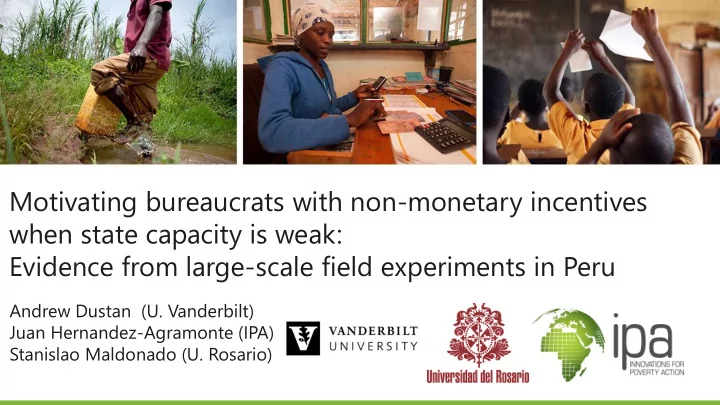

Motivating bureaucrats with non-monetary incentives when state capacity is weak: Evidence from large-scale field experiments in Peru Andrew Dustan (U. Vanderbilt) Juan Hernandez-Agramonte (IPA) n Stanislao Maldonado (U. Rosario)
Key findings Supportive evidence about the role of behavioral-based non- 1 monetary incentives as a tool to increase compliance among civil servants 2 Context matters for optimal design of these type of incentives Flexible and low cost strategy to address principal-agent problems 3 when state capacity is low
Policy Issue Setting the scene State´s effectiveness depends on quality of civil servants (Finan et al., 2017) ¿How to improve civil servant´s capacity in a context where: i. state capacity is low, ii. cost of enforcement is high? Recruit better not always possible (Dal Bo et al., 2013; Ahsraf et al., 2018) * Monetary incentives? Well studied (Finan et al., 2017) but expensive at scale. * We know less about non-monetary incentives for civil servants (Ashraf et al. 2014, * Islam et al. 2017, Banerjee et al. 2014, Khan et al. (2018)) e.g. rooted in behavioral economics.
Can non-monetary incentives, based on behavioral insights, increase the capacity of the state to improve civil servants’ performance compliance at scale?
Details of evaluation Tool: SMS (text message) campaign w/behavioral content 3 RCTs in 2 nationwide social programs Benchmark experiment: MINEDU (MineduLab) 2015 Replication experiment: MINEDU (MineduLab) 2016 External validity experiment: Cuna Más 2016
Benchmark experiment Setting the scene National Program of Educational Infrastructure (PRONIED) MoE Funds transferred to schools for maintenance work Compliance Cycle of activities (1) Incomplete bank account Principal files plan of work • withdrawals: not all funds executed - Government transfers $ to • > potential that not all planned work National Bank account is completed. Implementation of • COMPLIANCE GAP maintenance activities (2) Expenditure report not filed: (withdraw cash, spend) Quality control and accountability. File expense report online •
Intervention SMS CAMPAIGN CHARACTERISTICS • 5 SMS during three months • Messages targeted an activity: file of plan, withdraw of funding, file expense report. • Behavioral tools: * Personalized messages (Karlan et al 2016) * Use of (exogenous) deadlines (Ariely et al 2002) * 5 Behavioral content: variation across treatments
Intervention n = 24,257
Outcomes Being Studied Combination of administrative data and primary data (surveys) Focus on expense report. Source -> • Wasichay system (PRONIED Information system). Reports of bank balances [Similar • effects]. Source -> National Bank account data.
SMS increases expense report filing rate Receiving any message reduces by 15% the compliance gap
Replication: No evidence of fatigue or persistence Average impact of SMS on filing expense report by 2015-2016 status Control mean: 80.6%
External Validity Experiment": SMS campaign in another setting (Cuna Más) • Replicate with case managers who file monthly reports of household visits • 3 SMS per month with two treatments: i. Monitoring and ii. Social norm Low tenure contracts (can be fired) Control mean: 70.14%
Results and conclusions Supportive evidence about the role of behavioral-based non- 1 monetary incentives as a tool to increase compliance among civil servants 2 Low cost strategy to address principal-agent problems Context matters for optimal design of messages -> A/B testing 3 Results were basis for design and implementation of a national 4 policy: 24,000 schools with cellphone connection.
Thank you poverty-action.org
Dynamics of treatment effects
Recommend
More recommend